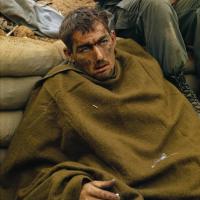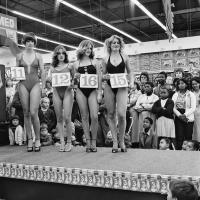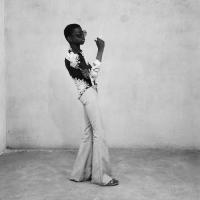Photo Gallery: Everything was Moving - Photography from the 60s and 70s, Barbican Gallery | reviews, news & interviews
Photo Gallery: Everything was Moving - Photography from the 60s and 70s, Barbican Gallery
Photo Gallery: Everything was Moving - Photography from the 60s and 70s, Barbican Gallery
A thoughtful and deeply disturbing exhibition which manages to speak with unparalleled directness

Take the day, and a stiff drink afterwards, as you’ll need it for this thoughtful and deeply disturbing exhibition. A picture, goes the cliché, is worth a thousand words, and nowhere more so than in this heartbreaking, beautiful and affecting anthology, which manages to speak with unparalleled directness, yet with nuanced subtlety.
Here are over 400 photographs by 12 artists, spanning the world, and shown with outstanding clarity, helpful pacing and variety. It is a self initiated record of perhaps the greatest turning points of the last century as the world moved on from centuries of Eurocentric dominance, and its American neo-colonialism successor, to the evolving economic and social map that is engulfing us now.
You will be immersed in complexity and transfixed by a telling visual simplicity
What is on view is a testament to the uncanny and acute eye behind the camera which should put to rest forever all those endlessly boring debates about art vs documentary, while continuing to raise the insoluble conundrum that photography can make something so beautiful and captivating out of the sad, the ghastly, the horrible or the simply mundane.
Bruce Davison’s dangerous forays into the Sixties Freedom Rides civil rights protests delineate the true horrors of southern racism. The discovery of the black South African Ernest Cole’s extensive essays of his racially divided society, all accomplished before he was 26. Cole, who was a black man illegally posing as "coloured" under the regime's racial coding system (as a black man he would not have been able to work as either a journalist or a photographer), shows us, with the sharpest yet most tender of eyes, apartheid in daily life: at a railway station, crowds of blacks are so pushed and packed together they are nearly falling off the platform, while a handful of well-dressed whites stand just a few feet away. He shows us the indignities of the pass system, the stop and search, the miners far away from home, the maids good enough to bring up the white children, while separated from their own, and all within living memory (the current furore over the internationally owned platinum mines could not be more topical).
There is David Goldblatt’s immersion in Soweto, and in a white town, Boksberg, trenchant and powerful visual essays. Li Zensheng’s unique stitched together panoramas of the enormous crowds at rallies in praise of Mao and the Cultural Revolution, providing the most complete record anywhere. Sigmar Polke’s curiously distressing scenes of a big bear and two dogs fighting it out to the death for the entertainment of the tribesmen of the Hindu Kush. Here, too, is Larry Burrows, the great war photographer shot down over Cambodia, with huge colour photographs of wounded American militia, as awful and as beautiful as any Renaissance painting of torture and death.
There is though a curious optimism. These are societies under observation, brutality versus dignity and tenacity, societies beginning to break through the endemic racism and disfiguring totalitarianism that have disfigured human society for millennia, just a chink of light shining through made visible by these heroes of the camera.
Oh, just go and see it. You will be surprised, astonished and moved, immersed in complexity and transfixed by a telling visual simplicity. It is a crash course in the aesthetics of photography in the hands and eyes of a dozen practitioners, who have married acute and intense attention to the observable world with highly individual imagination and intelligence. The results are unexpected and immensely powerful.
- Everything Was Moving: Photography from the 60s and 70s at Barbican Gallery until 13 January 2013
Click on the image to enlarge
Explore topics
Share this article
The future of Arts Journalism
You can stop theartsdesk.com closing!
We urgently need financing to survive. Our fundraising drive has thus far raised £49,000 but we need to reach £100,000 or we will be forced to close. Please contribute here: https://gofund.me/c3f6033d
And if you can forward this information to anyone who might assist, we’d be grateful.

Subscribe to theartsdesk.com
Thank you for continuing to read our work on theartsdesk.com. For unlimited access to every article in its entirety, including our archive of more than 15,000 pieces, we're asking for £5 per month or £40 per year. We feel it's a very good deal, and hope you do too.
To take a subscription now simply click here.
And if you're looking for that extra gift for a friend or family member, why not treat them to a theartsdesk.com gift subscription?
more Visual arts
 'We are bowled over!' Thank you for your messages of love and support
Much-appreciated words of commendation from readers and the cultural community
'We are bowled over!' Thank you for your messages of love and support
Much-appreciated words of commendation from readers and the cultural community
 Lee Miller, Tate Britain review - an extraordinary career that remains an enigma
Fashion photographer, artist or war reporter; will the real Lee Miller please step forward?
Lee Miller, Tate Britain review - an extraordinary career that remains an enigma
Fashion photographer, artist or war reporter; will the real Lee Miller please step forward?
 Kerry James Marshall: The Histories, Royal Academy review - a triumphant celebration of blackness
Room after room of glorious paintings
Kerry James Marshall: The Histories, Royal Academy review - a triumphant celebration of blackness
Room after room of glorious paintings
 Folkestone Triennial 2025 - landscape, seascape, art lovers' escape
Locally rooted festival brings home many but not all global concerns
Folkestone Triennial 2025 - landscape, seascape, art lovers' escape
Locally rooted festival brings home many but not all global concerns
 Sir Brian Clarke (1953-2025) - a personal tribute
Remembering an artist with a gift for the transcendent
Sir Brian Clarke (1953-2025) - a personal tribute
Remembering an artist with a gift for the transcendent
 Emily Kam Kngwarray, Tate Modern review - glimpses of another world
Pictures that are an affirmation of belonging
Emily Kam Kngwarray, Tate Modern review - glimpses of another world
Pictures that are an affirmation of belonging
 Kiefer / Van Gogh, Royal Academy review - a pairing of opposites
Small scale intensity meets large scale melodrama
Kiefer / Van Gogh, Royal Academy review - a pairing of opposites
Small scale intensity meets large scale melodrama
 Jenny Saville: The Anatomy of Painting, National Portrait Gallery review - a protégé losing her way
A brilliant painter in search of a worthwhile subject
Jenny Saville: The Anatomy of Painting, National Portrait Gallery review - a protégé losing her way
A brilliant painter in search of a worthwhile subject
 Abstract Erotic, Courtauld Gallery review - sculpture that is sensuous, funny and subversive
Testing the boundaries of good taste, and winning
Abstract Erotic, Courtauld Gallery review - sculpture that is sensuous, funny and subversive
Testing the boundaries of good taste, and winning
 Edward Burra, Tate Britain review - watercolour made mainstream
Social satire with a nasty bite
Edward Burra, Tate Britain review - watercolour made mainstream
Social satire with a nasty bite
 Ithell Colquhoun, Tate Britain review - revelations of a weird and wonderful world
Emanations from the unconscious
Ithell Colquhoun, Tate Britain review - revelations of a weird and wonderful world
Emanations from the unconscious
 Rachel Jones: Gated Canyons, Dulwich Picture Gallery review - teeth with a real bite
Mouths have never looked so good
Rachel Jones: Gated Canyons, Dulwich Picture Gallery review - teeth with a real bite
Mouths have never looked so good









Add comment